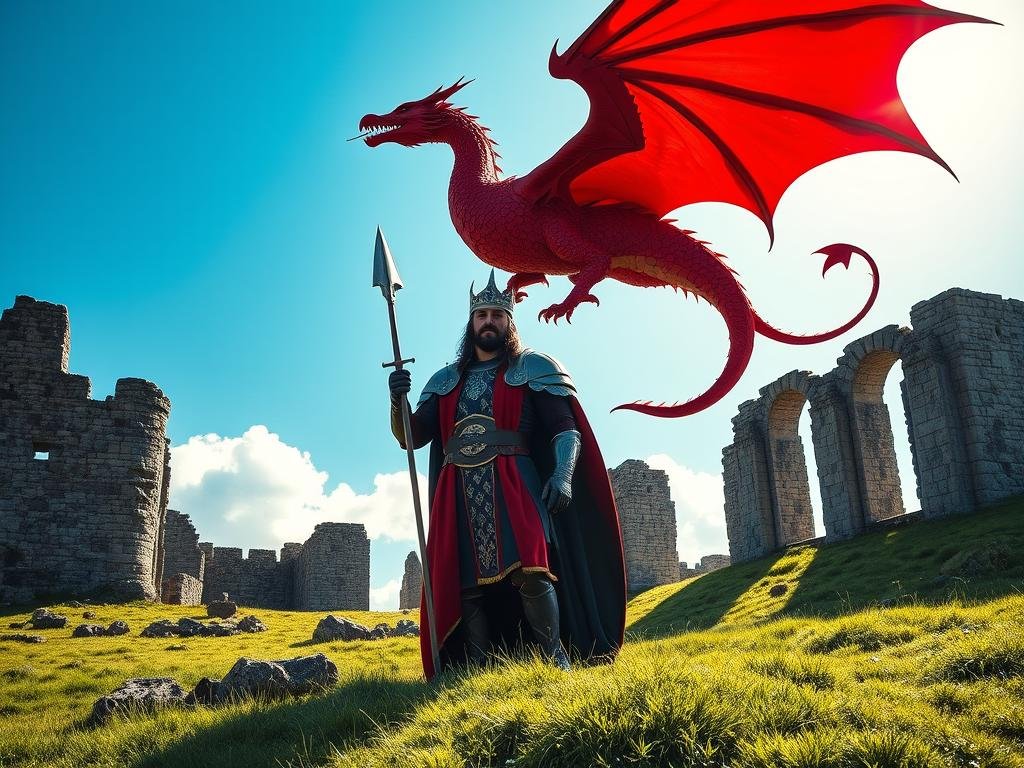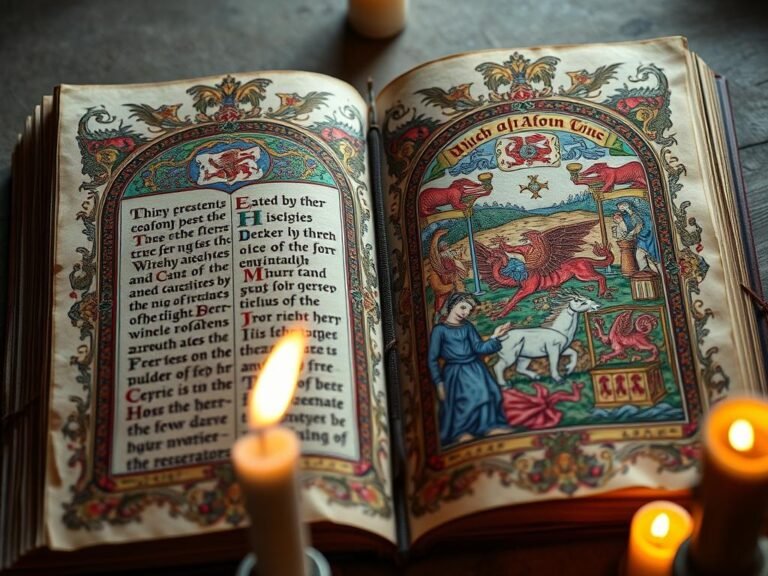Ah the history of the welsh dragon, our prized mythical beast. Did you know the Welsh Dragon, or Y Ddraig Goch, is very old and well-known? The flag of Wales, with the Red Dragon, was adopted in 1959. It’s one of the oldest national flags around today. This symbol has been linked to Wales for ages long time, showing the nation’s strength, heritage, and spirit.
The history of the welsh dragon starts with ancient Celtic myths and the Romans in Britain. The oldest record of the dragon as Wales’ symbol is from the Historia Brittonum, written by Nennius around 820. The Red Dragon has been key in Welsh culture, from the Battle of Crecy in 1346 to the Tudor dynasty’s rule from 1485 to 1603.
Now, the Welsh Dragon is a big part of Wales’ identity. It’s seen on flags, buildings, and even the national rugby team’s logo. It reminds us of Wales’ deep history and culture, showing the Welsh people’s resilience and pride.
The History Of The Welsh Dragon in Ancient Celtic Mythology
Quote: “In Celtic culture, dragons were considered protectors of the land, symbols of strength, wisdom, and natural forces.”
Source: Dr. Miranda Aldhouse-Green, The Celtic World
The Welsh dragon is a symbol of strength and heritage, rooted in Celtic mythology and welsh myths and legends. Before the Romans arrived, the Celts saw dragons as powerful guardians. They believed these creatures brought wisdom and prophecy through dreams, becoming a big part of Welsh folklore and legend.

The famous story of the Welsh dragon comes from the 12th-century Historia Regum Britanniae by Geoffrey of Monmouth. It tells of two dragons, one red and one white, found in an underground lake. The red dragon won the battle, showing the Britons’ victory over the Saxons. This made the red dragon a symbol of Welsh pride and resistance.
Dragons were more than just symbols of power. In Celtic tradition, they were symbolic animals that represented the wild spirit of Wales. They watched over sacred places, kept ancient wisdom, and carried divine power. Stories of dragons filled Wales, from Snowdonia’s peaks to Pembrokeshire’s coastlines, shaping Welsh identity.
The red dragon has roots in Welsh folklore, often representing the Britons in the struggle against the Saxons, as seen in the tale of the battling dragons.”
Source: Geoffrey of Monmouth, Historia Regum Britanniae
Today, the Welsh dragon is everywhere, from sports teams’ shirts to food products and town flags. Its lasting popularity shows the deep importance of Celtic symbols in Wales and the magic of ancient Welsh legends. Exploring the dragon’s origins reveals a rich mix of myth, history, and pride that continues to inspire us.
The History Of The Welsh Dragon During the Roman Occupation of Britain
Quote: “The draco standard was not only a symbol of Roman military might but became intertwined with native legends, blending with Welsh folklore to solidify its place as a symbol of strength.”
Source: Dr. Peter Salway, A History of Roman Britain
The Welsh dragon emblem has deep roots in ancient times, during the Roman occupation of Britain. It was linked to the Roman cavalry’s “draco” symbols. These dragon-shaped standards were key on their banners and coins.

As the Romans spread across Britain, the dragon symbol merged with Welsh mythology. Stories of Cadwaladr, the King of Gwynedd (you can read about him within my ancient Wales section), and the Dinas Emrys dragon myth with King Vortigern, featured the dragon. These tales were influenced by the Romans.
Adoption of the Dragon Symbol by Welsh Kings
Cadwaladr’s use of the dragon emblem signified Welsh kings’ intent to claim ancient heritage and assert their authority as heirs to a proud Celtic legacy.”
Source: Professor John Davies, A History of Wales
After the Romans left Britain, Welsh kings like Cadwaladr took the dragon as their symbol. The dragon of Cadwaladr became a key emblem in Welsh heraldry. It showed the Welsh people’s strength and resilience.
The Dinas Emrys Dragon Myth
The Dinas Emrys dragon myth is a key part of Welsh folklore. It tells of King Vortigern and his encounter with two dragons – one red, one white. This story deepened Wales’ connection to dragon mythology.
Over time, the red dragon became a symbol of Wales. It represents the nation’s fierce independence and cultural heritage. Today, it’s proudly displayed on the Welsh flag and celebrated in art, literature, and music.
The Welsh Dragon in Arthurian Legends
In Welsh mythology, the dragon symbolises the spirit of Wales, as demonstrated in Merlin’s prophecy, which foretold the victory of the red dragon over the white, symbolising Welsh resilience.”
Source: Geoffrey of Monmouth, Historia Regum Britanniae
The history of the welsh dragon even covers King Arthur’s time.The mythical Welsh dragon is a symbol of strength and heritage. It is deeply connected to King Arthur’s legendary tales. Arthur’s father, Uther Pendragon, had the dragon emblem, which Arthur later inherited. The name “Pendragon” means “head dragon” or “chief dragon,” showing the dragon’s importance in Arthurian legends.

Merlin’s famous prophecy in Welsh mythology talks about a battle between a red and a white dragon. It says the red dragon, symbolising the Britons, will defeat the white dragon, which represents the Anglo-Saxons. This story deeply resonated with the Welsh, who saw themselves as defenders of their land.
King Arthur’s Connection to the Red Dragon
King Arthur, the legendary Welsh hero, carried the red dragon standard into battle. This symbol gave him strength and courage. The dragon reminded him of his father’s legacy and his own mythical origins.
The Welsh dragon emblem became a powerful national symbol during the medieval period, linked with King Arthur’s own standard of the Pendragon, or ‘chief dragon.’”
Source: Dr. Ronald Hutton, The Pagan Religions of the Ancient British Isles
Merlin’s Prophecy of the Battling Dragons
Merlin’s prophecy of the battling dragons is a key part of Welsh mythology. It says the red dragon, representing the Welsh, will fight the white dragon, symbolising the Anglo-Saxons. The prophecy promises the red dragon will win, ensuring the Welsh nation’s survival and resilience.
These Arthurian legends have fascinated people for centuries. They show the lasting impact of mythology on national identity and cultural pride. The Welsh dragon, linked to King Arthur and Merlin’s prophecy, is a vital part of Wales’ history.
Adoption of the Red Dragon as the Official Flag of Wales
The Welsh flag, featuring the red dragon on a green and white background, was officially adopted in 1959, but its heritage dates back to Celtic and Roman influences.”
Source: National Museum of Wales
Considering the colourful history of the welsh dragon, You’d be understandably mistaken thinking it has been adopted as the flag we know and love today.
The meaning of the Welsh flag is deeply rooted in Wales’ rich history and mythology. The iconic red dragon, or Y Ddraig Goch, has been a symbol of Wales for centuries. It first appeared in ancient Celtic mythology and Arthurian legends. But it wasn’t until 1959 that the red dragon flag became the national flag of Wales.
The current Welsh flag shows a red dragon on a green and white background. The green and white colours were added by Tudor king Henry VII. This change happened in 1959, making the red dragon flag a symbol of Welsh pride and heritage.
Before it was officially adopted, the red dragon was used by Welsh rulers and in important historical events. In 1807, it became the Royal Badge of Wales. Owain Glyndŵr, a Welsh ruler in the early 15th century, used a golden dragon standard in his revolts against the English. The Tudors, like Henry VII, also used it during the Battle of Bosworth in 1485.
The history of the welsh flag is linked to Wales’ struggle for identity and independence. In the early 20th century, there was a movement to make the red dragon the official symbol of Wales. Between 1910 and 1916, the Caernarfon town council wanted to fly the Welsh flag on Caernarfon Castle’s Eagle Tower, replacing the Union Jack. In 1953, the motto “Y Ddraig goch ddyry cychwyn” was added to the flag, highlighting its importance in Welsh heraldry.
Today, the red dragon flag is flown from the Senedd in Cardiff, Welsh Government buildings, and UK Government buildings in Wales. It reminds us of Wales’ distinct cultural identity and the people’s spirit. The Welsh flag’s origins and the history of the red dragon show the lasting legacy of this ancient symbol. It continues to inspire and unite the Welsh nation.
The red dragon is more than a flag symbol; it embodies the struggle, resilience, and unique cultural identity of the Welsh people.”
Source: Dr. Simon Jenkins, Welsh historian and author
The Enduring Popularity of the Welsh Dragon in Modern Culture
Quote: “The red dragon continues to represent the enduring spirit of Wales. It’s a symbol that transcends centuries, standing as a testament to Welsh resilience and pride.”
Source: Dr. Elin Jones, University of Wales
The iconic red dragon, or y ddraig goch, is a symbol of Welsh pride today. It’s a creature from medieval Welsh legends that captures the hearts of many. It shows the rich cultural heritage of Wales.
The red dragon is seen everywhere in Wales. It’s on flags, banners, coins, and in heraldry. Its image on the national flag brings the Welsh people together. It’s more than just a picture; it’s the spirit of Wales.
Welsh businesses and organisations love the red dragon. They use it in their logos and branding. This shows its lasting appeal and the pride it brings to Wales.
The Dragon in Contemporary Welsh Art, Literature, and Music
The red dragon appears in Welsh art, literature, and sport, symbolising national pride and identity, from the Welsh rugby team’s logo to business emblems across the country.”
Source: Welsh Government Heritage Publications
The red dragon inspires artists, writers, and musicians in Wales today. It’s a symbol of Welsh strength and identity. It’s found in paintings, sculptures, literature, and music.
In books, the dragon stands for Welsh resilience and pride. Musicians also use dragon themes in their songs. They honour their Welsh roots through their music.
The Welsh dragon brings people together, reminding them of their shared history. Its lasting popularity shows the Welsh love for their heritage. The legend of y ddraig goch will live on for many years.
History of the Welsh Dragon: Key Takeaways
- The Welsh dragon has a long and interesting history. It started in ancient Celtic myths and is now Wales’ official symbol. This symbol has changed over time but always shows Welsh strength and pride.
- Dragons first appeared in Wales in the 6th century. They were in early Welsh texts and legends. One famous story is of Llydd and Llefelys, where a red dragon fights a white one. This story shows the Welsh and English struggle.
- Over time, the dragon changed from a snake-like creature to a four-legged, winged beast. It became more popular between the 5th and 10th centuries. The red dragon became a symbol of Welsh rulers, like Cadwaladr in the 7th century and Owain Glyndŵr in the 15th century.
- The legend of Merlin in the 12th century made the red dragon even more important. It was seen as a sign of King Arthur’s coming. This linked the dragon’s story with Arthur’s legend.
- In 1807, the red dragon was officially accepted as Wales’ emblem. But it wasn’t until 1959 that the current Welsh flag was made. This flag has the red dragon on a green and white background. The Gorsedd of Bards helped make this flag the national flag.
- Today, the Welsh dragon is a symbol of Wales. It’s on flags, coats of arms, and in patriotic items. Its presence in Welsh culture shows its importance and the pride it brings to the Welsh people. The dragon’s history is one of resilience and the spirit of Wales.
Conclusion
The history of Welsh Dragon is more than a symbol; it’s the embodiment of Wales’ enduring spirit, resilience, and rich cultural heritage. From ancient Celtic myths to the flag that waves proudly today, the red dragon—Y Ddraig Goch—connects generations of Welsh people to their shared past and inspires them in the present. Its fierce image is a reminder of battles fought, legends woven, and a nation that has held onto its identity through centuries of change.
As the dragon continues to soar in Welsh art, literature, and everyday life, it stands as an eternal emblem of strength, pride, and the unbreakable bond between the Welsh people and their storied land.
Matt






